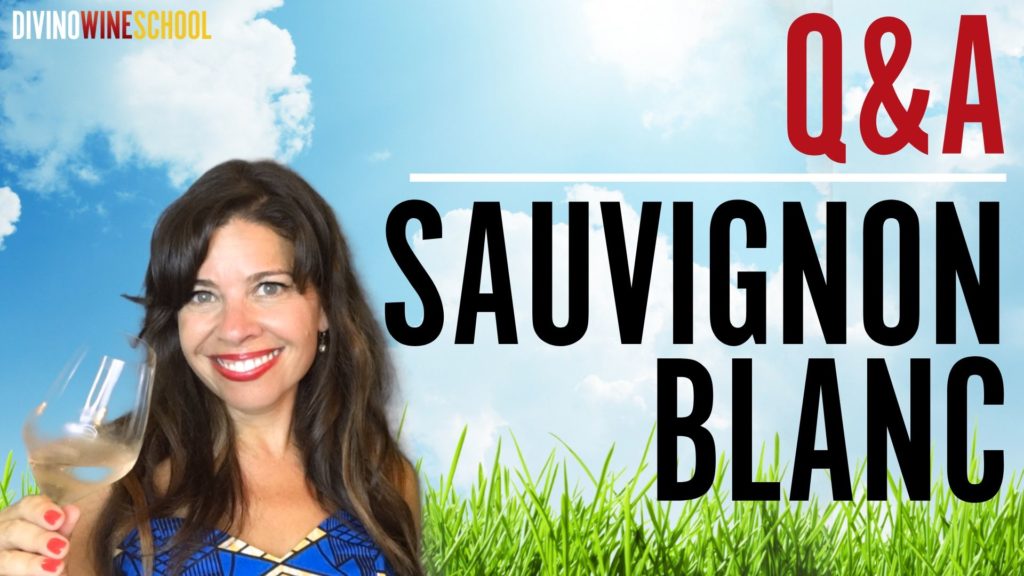DiVino may earn commissions from qualifying purchases.
Where is Sauvignon Blanc From?
Sauvignon Blanc (Grape and Wine) traces its roots to parts of Western France, in Bordeaux and the Loire Valley. The actual origin of the grape is unknown.
Sauvignon gets its name because it was growing rampantly, wild, or sauvage all over the place.
That may be where Sauvignon originated, but this bright and versatile white wine has taken the New World by storm. In addition to France and part of Italy, Sauvignon Blanc is cultivated and parts of North and South America, Australia, New Zealand, and South Africa, and the wines have remarkably distinctive characteristics. One aroma they all share is an element of green. Vegetal, leafy or grassy notes.
If you remember one thing about Sauvignon Blanc, remember GREEN.
Vegetal notes like bell pepper, jalapeno, lemon grass, asparagus, basil, and even peppercorn comes from volatile aromatic compounds called pyrazines. These, along with esters and terpenes, are found in the skins of the grapes.
Winemakers and scientists have discovered that the presence of these aromatic compounds have just as much to do with pruning in the vineyard as it does with the climate.
They seem to decrease in hotter regions and hotter growing seasons, as well as when the leaves are pruned to keep the grapes out of the shade. Wines made from grapes harvested later, also seem to exhibit fewer intense vegetal notes, whereas grapes harvested earlier, or younger, have more.

Tropical Fruit
Sauvignon is also beloved for its array of fruit notes. Among them are grapefruit, lime, gooseberry, peach, mango, kiwi, and starfruit, to name a few!
What does this mean for you?
The warmer and sunnier the climate, and the riper the grapes, the more intensely tropical the fruit notes are likely to be, whereas cooler climates produce grassier, more herbaceous wines. There is plenty of variation in the wine growing process, however, this is a general guide. Ask your wine shop or sommelier if you want to learn more.
ACIDITY
Climate and soil are also a factor when it comes to preserving acidity in the grape. Acidity accumulates as the grape berry develops. It requires a balance of elements and controlled temperatures.
Remember, acidity is a natural preservative. It acts like a backbone for the wine, to prop it up over time. On the palate it is crispness and freshness, just like a piece of fruit. Tart and bright notes are a sign of health, youth and freshness. When the acidity fades and the wine feels flat or flabby, it’s probably past its prime. Just like us! The only difference is that wine cannot get back in the gym or go on a diet.
Certain soil types also affect acidity. Limestone is particularly noted for promoting acid levels in grapes.
4 Soil Types to Know
- Sandy – Promotes drainage, resists pests, retains heat (softer tannins, smoother qualities, similar silkiness to cement tank fermentation.
- Clay – Retains moisture (big, pulpy and juicy grapes) controls temperature (cooler =aromatic intensity)
- Volcanic/ Rocky/ Gravel – Retains Moisture, alter the temperature by absorbing sunlight (heat), they also provide drainage
- Limestone/Calcareous – Nutrient rich, water retention and drainage adapt with the temperature
Sauvignon Blanc Growing Areas
Cool Climate
- France (Loire Valley) New Zealand (Marlborough)
- Coastal Chile (Casablanca)
- Northern Italy (Friuli)
- Coastal South Africa (Walker Bay)
Warm Climate
- California (Napa Valley, Central Coast)
- Washington State (Columbia Valley)
- Argentina (Mendoza)
- Spain (Jumilla)
FUN FACT!
Sauvignon Blanc, a white grape variety and Cabernet Franc, a black grape (what we think of as red) variety met and married in a vineyard produce Cabernet Sauvignon!

WHAT IS SANCERRE?
What is the difference Between Sauvignon Blanc and Sancerre?
Sancerre is a French wine Appellation d’Origine Contrôlée (AOC), a wine growing and producing area, located in the eastern Loire valley, south of Orleans, on the left bank of the Loire River. Just across the river is another AOC, Pouilly-Fumé, also known the world over for Sauvignon Blanc.
ABOUT BOSMAN (the wine from the video!)
Bosman Winery is in its 8th generation! These people are serious about wine growing and wine production. They’re also serious about protecting nature and the community. That means sustainable farming, fair trade practices, and generations of dedicated employees and their families who live and work on the winery and own a percentage of it. You can feel good about drinking Bosman wines, unless you drink too much. But that’s your own fault.
Walker Bay
Walker Bay is located in the southern coast of the Western Cape. Its proximity to the sea means constant cooling breezes. It’s one of the coolest regions and microclimates in South Africa.
In this case, the vineyards are planted in the Upper Hemel-enAarde Valley which also known for an indigenous flower kingdom called Fynbos. They’re actually flowering shrubs and they come in all sizes in colors, and only grow in this area!
As we said before, cooler climates tend to produce greener or grassier Sauvignon Blanc. In this the grassy shrublands surrounding the vineyards impact the herbaceous quality of the wine.
Want to learn more about pairing Sauvignon Blanc with food? Check out our guide, “How to Pair Food and Wine.”



